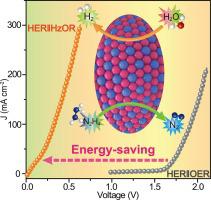Journal of Colloid and Interface Science ( IF 9.4 ) Pub Date : 2023-09-02 , DOI: 10.1016/j.jcis.2023.09.003 Yujun Zhao 1 , Yu Sun 1 , Haibo Li 1 , Suyuan Zeng 1 , Rui Li 1 , Qingxia Yao 1 , Hongyan Chen 1 , Yao Zheng 2 , Konggang Qu 1

|
The low-potential hydrazine oxidation reaction (HzOR) can replace the oxygen evolution reaction (OER) and thus assemble with the hydrogen evolution reaction (HER), consequently achieving energy-saving hydrogen (H2) production. Notably, developing sophisticated bifunctional electrocatalysts for HER and HzOR is a prerequisite for efficient H2 production. Alloying noble metals with eligible non-precious ones can increase affordability, catalytic activity, and stability, alongside rendering bifunctionality. Herein, RuNi alloy deposited onto carbon (RuNi/C) was directly prepared by a simple and highly practical co-reduction method, showing excellent performance for HER and HzOR. Interestingly, to achieve 10 mA cm−2, RuNi/C only required an ultralow potential of 24 mV for HER, on par with commercial 20 wt% platinum in carbon (Pt/C), and −65 mV for HzOR, surpassing most reported counterparts. Moreover, the two-electrode electrolyzer only required small operation voltages of 57.8 and 327 mV to drive 10 and 100 mA cm−2, respectively. Driven by a homemade hydrazine (N2H4) fuel cell and solar panel, appreciable H2 yields of 1.027 and 1.406 mmol h−1 were achieved, respectively, exhibiting the energy-saving advantages alongside robust practicability. Moreover, theoretical calculations revealed that alloying with Ru endows bifunctional Ni sites not only with a lower H2O dissociation barrier but also with more favorable H* adsorption alongside the reduced energy barrier between HzOR intermediates.
中文翻译:

通过合金化定制的双功能镍高度增强肼氧化,用于高效节能的氢气生产
低电位肼氧化反应(HzOR)可以替代析氧反应(OER),从而与析氢反应(HER)结合,从而实现节能的氢气(H 2 )生产。值得注意的是,开发用于 HER 和 HzOR 的复杂双功能电催化剂是高效生产 H 2的先决条件。将贵金属与合格的非贵金属合金化可以提高经济性、催化活性和稳定性,同时具有双功能。在此,通过简单且高度实用的共还原方法直接制备了沉积在碳上的RuNi合金(RuNi/C),显示出优异的HER和HzOR性能。有趣的是,要实现 10 mA cm -2,RuNi/C 对于 HER 仅需要 24 mV 的超低电势,与商用 20 wt% 铂碳 (Pt/C) 相当,对于 HzOR 则需要 -65 mV,超过了大多数报道同行。此外,双电极电解槽仅需要57.8和327 mV的小工作电压即可分别驱动10和100 mA cm -2。在自制联氨(N 2 H 4)燃料电池和太阳能电池板的驱动下,H 2产率分别达到1.027和1.406 mmol h -1,展现出节能优势和强大的实用性。此外,理论计算表明,与Ru合金化赋予双功能Ni位点不仅具有较低的H 2 O解离势垒,而且具有更有利的H*吸附以及HzOR中间体之间的能垒降低。































 京公网安备 11010802027423号
京公网安备 11010802027423号